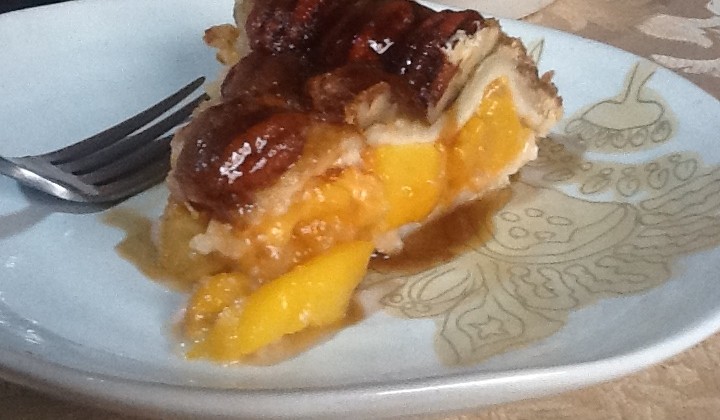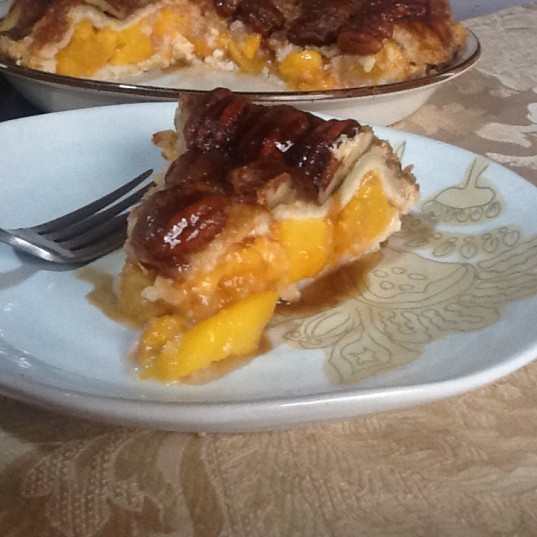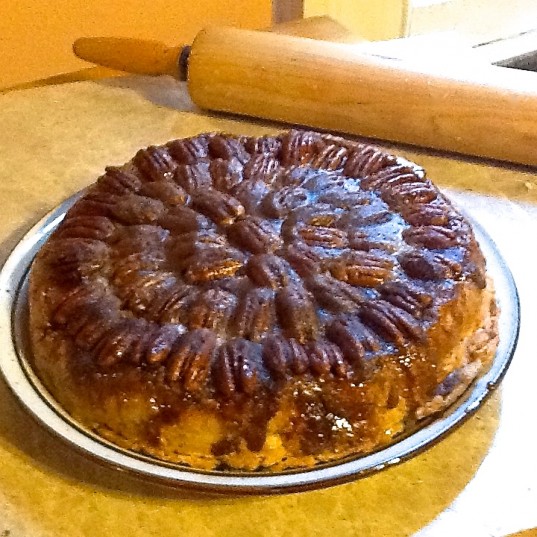Race, Southern Food and an Upside Down Peach Pecan Pie
Last month was quite an extraordinary month in America. Confederate flags came down in at least one Southern state, and its days are clearly numbered in many other places.
Here in New Orleans, our mayor made this statement:
“On this day, let me, as the chief executive officer of this government, in this city, that at one moment in history sold more slaves into slavery than anywhere else in America, apologize for this country’s history and legacy of slavery.” And there is serious talk of replacing New Orleans’ monuments to Confederacy figures.
Parenthetically, the U.S. Supreme Court upheld the rights of same sex couples to marry in every state , and it became the law of the land – same sex marriage, an issue that really gained traction when it began to be seen in the public’s eye as a civil rights issue, in the same vein as the civil rights of black Americans.
On a personal level, I spent the last weekend in June attending the Southern Foodways Alliance Symposium here in the Crescent City. At the first session I attended (on Food Justice), Catarina Passidomo, Assistant Professor of Anthropology and Southern Studies at the University of Mississippi, interviewed Jenga Mwedno, a community organizer in New Orleans’ lower 9th Ward (one of several food deserts here), on her work with Backyard Gardener’s Network. Ms. Mwedno began with this statement: “First we have to talk about white supremacy.”
While we had fun, ate amazing food at some of New Orleans’ best restaurants and sampled a couple of the city’s over the top crazy cocktails, there was also serious discussion. The issue of race was never too far away, as is fitting in a symposium on southern food. The South encompasses almost a third of this country, and many of the country’s most beloved dishes have Southern roots. Southern food was created, in large part, by enslaved Africans, and in fact, in many cases, Africans were targeted and brought to the Americas specifically for their knowledge of the cultivation of certain foods – most notably rice. Rice seed was packed along with the human “cargo” on ships traveling across the Atlantic. The industry of sugar cultivation could not have thrived without slaves – who were especially considered dispensable on sugar plantations – and in the mid-19th century, a Louisiana free person of color, Norbert Rillieux, invented a machine that revolutionized the sugar refining process, although he never received the the kind of notoriety for it that Caucasian inventors of that century did. Other Southern favorites, like okra, black eyed peas and fritters, are foods that came directly from Africa, too.
Again, on a personal note, if any of those monuments to Confederate figures do get replaced in New Orleans, I would love to see a monument honoring the thousands of unnamed African slaves and free people of color who created this unique culture – the cuisine, music, architecture, and brick and iron work they built – that not only we, who live here, but also people traveling from all over the world, enjoy.
Since all of us in this country have our biases about race, I have to admit that I was surprised that so much of the discussion at the Symposium acknowledged the issue of race, as most of the participants were white (and I use that word for lack of better terminology) Americans. I also have to say, that since I’ve been here in New Orleans, it seems that race, although it was never very distant before, has been on the front burner of my consciousness almost continuously. So though I really don’t have a whole lot more to say about all of this right now, I recognize this moment as an important one in our history as a people, and it’s an issue I hope to explore more in my writing.
I do, however, since, this is a ostensibly a blog focused primarily on food, and often shares recipes, have a story to recount from my culinary school days. I spent most of a year with fifteen other people – in a not exactly state of the art kitchen – cooking, jostling for space and equipment, and cleaning up after ourselves seven and a half hours a day, five days a week. We were a very diverse group, and as you can imagine, there were definitely annoyances. One of the people I most often found annoying, one day announced proudly that she had made an old plantation recipe. An old plantation recipe? More like an old slave recipe, my monkey mind grumbled. I recognized pretty quickly that the Upside Down Apple Pecan Pie she made was a recipe from the River Road* Cookbook – a community cookbook found in many kitchens across Southern Louisiana. Also over the Symposium weekend, I got schooled (again) in the value of eating seasonally and locally – a task I must admit I found easy enough to adhere to in Southern California, which is blessed with very long growing seasons and lots of land (sigh…), but is a bit more challenging here. In light of that, I have adapted the apple pie to a peach one.
* River Road follows the Mississippi upriver from New Orleans to Baton Rouge and is lined with old plantation houses.
Upside Down Peach Pecan Pie
- 5 tablespoons unsalted butter
- 2/3 cup brown sugar
- 2 teaspoons corn syrup
- 1 teaspoon water
- @ 1 cup large pecans halves
- @ 6 medium to large peaches, peeled and sliced
- 5 tablespoons sugar
- Juice of 1 lemon
- 1/4 cup orange juice
- 2 tablespoons quick cooking or instant tapioca
- 1 recipe Cream Cheese Pie Crust
- Cream the butter, sugar, corn syrup and water together in a mixer bowl. Spread it evenly on the bottom of a pie dish (I used a glass one). Then press the pecans in a circular pattern into the butter/sugar mixture.
Roll out half the pie dough to 1/8 to 1/4 inch thickness and place over the pecans in the pie dish. Refrigerate dish with the dough and pecans while blanching , peeling and slicing the peaches. - In a large bowl toss the peeled peach slices with the lemon and orange juices, sugar and tapioca. Place them over the bottom pie crust. Roll out the remaining pie dough and place it over the top of the peaches, sealing the edges. You may refrigerate the pie again for a while to allow the dough to relax, if you like.
- Bake the pie at 450 degrees for 10 minutes, then at 350 degrees for another 40 minutes, until the top crust browns. Remove the pie from the oven and allow to relax a minute or tow on a wire rack. When the sugar stops bubbling, carefully flip the pie over onto a plate.
Cream Cheese Pie Crust Adapted from Rose Levy Beranbaum’s The Pie and Pastry Bible
- 12 tablespoons very cold unsalted butter, cut into cubes
- 2 cups (dip and sweep method) bleached all-purpose flour, chilled
- 1/4 teaspoon salt
- 1/4 teaspoon baking powder
- 4 1/2 ounces very cold cream cheese, cut into cubes
- 2 tablespoons ice cold water
- 1 tablespoon cider vinegar
- Place the flour,salt and baking powder in the bowl of a food processor with the metal blade and pulse it for a few seconds to combine.
- Add the cream cheese to the flour. Process for about 20 seconds or until the mixture resembles coarse meal. Add the butter cubes and pulse until none of the butter is larger than the size of a pea. (You may toss it with a fork to see it better.) Remove the cover and add the water and vinegar. Pulse until most of the butter is reduced to the size of small peas. The mixture will be in particles and will not hold together. Dump the mixture onto a large piece of plastic wrap kneading and pressing lightly, bringing it together, until the mixture holds together.
- Bring the ends of the plastic wrap up around the dough to cover it, flatten it into a disc and refrigerate for for about an hour, at least, or preferably overnight.









4 Comments
A pretty pie for a complex subject. I admire your words. GREG
July 22, 2015
This is a great suggestion you make, Gisele: “…I would love to see a monument honoring the thousands of unnamed African slaves and free people of color who created this unique culture – the cuisine, music, architecture, and brick and iron work they built – that not only we, who live here, but also people traveling from all over the world, enjoy.”
August 18, 2015
i made apple pie version with my vintage river road recipes book (42nd printing) and it was terrific. i appreciate the recipe more now having heard the back story.
March 15, 2017
Love this post and it’s discussion of the history of food cultivation in New Orleans. Gotta try the recipe!!
April 18, 2023